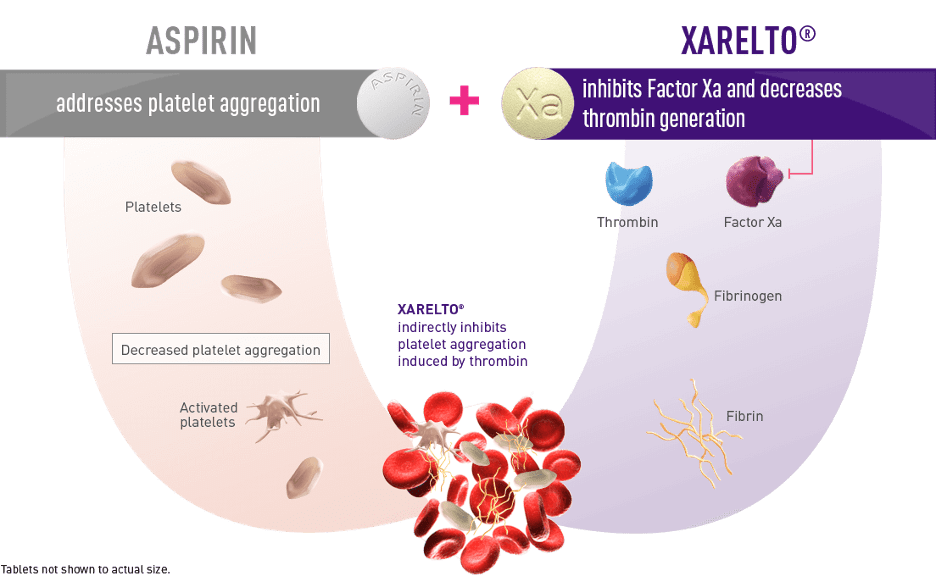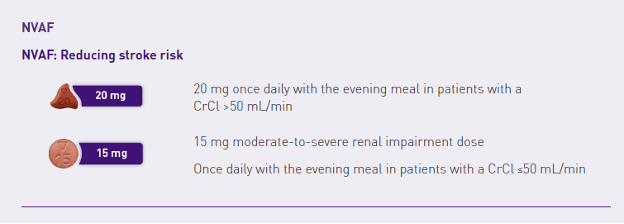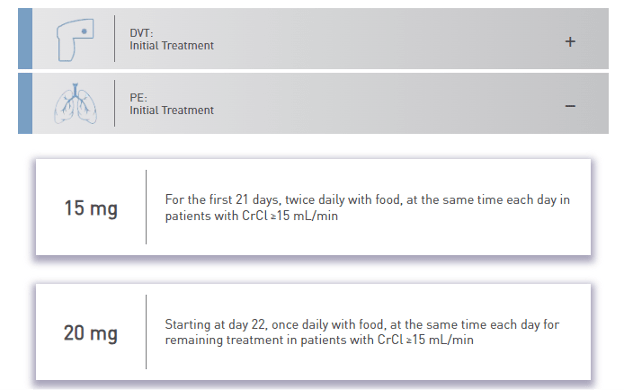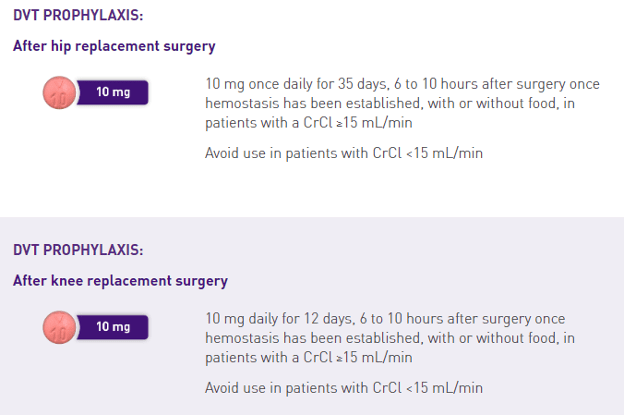Table of Contents
II. Factors Influencing Xarelto Dosage
III. Common Xarelto Dosage Recommendations
IV. Monitoring and Adjusting Your Dosage
Navigating the world of anticoagulants can be complex, with each drug presenting its own set of unique considerations. Xarelto (generic name rivaroxaban) is a prominent medication in this field, and offers significant advantages that can simplify its usage. But, like all medications, understanding the nuances of Xarelto dosage is key to ensure it performs as needed for individuals taking it.
Plus, getting your Xarelto dosage right minimizes adverse side effects so you can enjoy everyday life without the worry of feeling poorly thanks to your medicine.
In this article, we’ll cover all the details you need to know about determining the right Xarelto dosage for you—factors that influence dosage, common recommendations, how to monitor, and more.
Quick Takeaways:
- Xarelto (generically rivaroxaban) is a popular anticoagulant used to treat conditions such as atrial fibrillation, deep vein thrombosis (DVT), and pulmonary embolism (PE).
- It’s often prescribed in post-surgical patients to reduce the risk of blood clot and stroke.
- Factors influencing Xarelto dosage include medical history, concurrent medications, age and weight considerations, and the purpose for prescription.
- While common dosage recommendations exist, it’s imperative to consult directly with your healthcare provider to get your dosage right.
What is Xarelto?
Xarelto, generically known as rivaroxaban, is a popular anticoagulant or blood thinner. Unlike traditional anticoagulants like warfarin, which require frequent dose adjustments and monitoring, Xarelto provides a more predictable and consistent effect without the need for routine blood tests. For this reason, it’s a preferred choice by both patients and providers.
The primary role of Xarelto is to prevent the formation of blood clots. It specifically inhibits Factor Xa, an essential component in the coagulation pathway, thus reducing the risk of clot formation. Because of this action, Xarelto is commonly prescribed for conditions like atrial fibrillation (an irregular heart rhythm), which increases the risk of stroke due to clot formation.
It's also beneficial for treating deep vein thrombosis (DVT) and pulmonary embolism (PE) and can be used as a preventive measure against these conditions, especially post-surgery, in patients undergoing hip or knee replacement.

With cardiovascular diseases a leading cause of morbidity and mortality worldwide, drugs like Xarelto are revolutionizing patient care. They offer a more streamlined approach to anticoagulation therapy, optimizing the balance between preventing dangerous clots and minimizing risk of excessive bleeding.
The Importance of Getting Xarelto Dosage Right
Correct medication dosage, especially with drugs like Xarelto, is akin to walking a tightrope. On one side, under-dosage can render the medication ineffective, leaving patients vulnerable to the very risks, such as clot formation, the drug aims to prevent. On the flip side, an overdose can lead to excessive bleeding, posing another set of significant health threats.
The intricacies of anticoagulant therapy lie in achieving a therapeutic balance. The goal is to prevent or treat blood clots effectively without causing undue bleeding. Missing the mark in either direction can lead to serious consequences.
For example: In patients with atrial fibrillation, an inadequate Xarelto dosage may not sufficiently reduce the risk of stroke, while an excessive dose might lead to hemorrhagic complications.
Furthermore, individual variations, from genetics to diet, can influence how a patient responds to a given dosage. This variability underscores the importance of personalizing Xarelto dosage based on individual needs and circumstances.
Factors Influencing Xarelto Dosage
Determining the correct Xarelto dosage isn't a one-size-fits-all process. Several factors come into play, ensuring that each individual receives the most appropriate dose tailored to their unique situation.
1. Patient's Medical History
Medical history is a primary determinant of the right Xarelto dosage. Past incidences of clotting events, bleeding disorders, or strokes can influence the prescribed dosage. For example, a patient with a history of recurrent deep vein thrombosis might require a different approach than someone taking Xarelto as a preventive measure following surgery.
Kidney and liver functions are also paramount, as they play roles in drug metabolism and elimination. Compromised organ function can necessitate dosage adjustments to avoid potential drug accumulation and associated risks.
2. Concurrent Medications
Drug interactions significantly influence Xarelto dosage decisions. Some drugs, when taken concurrently with Xarelto, can increase its blood levels, enhancing the risk of bleeding. Conversely, other medications might reduce its efficacy, increasing clotting risks.
Antifungal agents, certain antiretroviral drugs, and even some over-the-counter medications can interact with Xarelto. It’s crucial to give healthcare providers a comprehensive list of medications and supplements to ensure they can accurately adjust the Xarelto dose as needed.
3. Age and Weight Considerations
Both age and weight can affect drug metabolism. Elderly patients may have altered drug distribution and clearance patterns, necessitating dosage tweaks. Similarly, body weight can influence drug volume distribution. For some patients, especially those at the extremes of body weight, standard dosages might either be too potent or insufficient, making weight-based adjustments critical.
4. Purpose of Therapy
The indication for Xarelto also dictates its dosage. Preventing clot formation after an orthopedic surgery might require a different dose than treating an active case of pulmonary embolism. Moreover, the duration of therapy might vary, with some conditions necessitating short-term use and others requiring extended or even lifelong therapy.
Common Xarelto Dosage Recommendations
Xarelto's versatility in treating and preventing various conditions is reflected in its varied dosage recommendations. However, it's imperative to understand these are general guidelines, and the precise dosage should always be determined by a healthcare professional.
Xarelto Dosage for Atrial Fibrillation
For patients with non-valvular atrial fibrillation, the typical recommended dosage is 20 mg once daily, taken with the evening meal. This dosage aims to reduce the risk of stroke and systemic embolism. A 15mg dosage may be prescribed for people with renal impairment.

Dosage for Deep Vein Thrombosis and Pulmonary Embolism
When treating active cases, the usual starting dosage is 15 mg taken twice daily for the initial 21 days. After this initial phase, the dosage often transitions to 20 mg once daily for the continued treatment and risk reduction of recurrent events.

Alt-Text: Common Xarelto dosage for DVT and PE is 15mg for the first 21 days twice daily, then 20mg once daily after day 22.
Dosage for Post-Surgical Patients
For patients undergoing hip or knee replacement surgery, the recommended dosage is 10 mg of Xarelto taken once daily. The duration of therapy varies; it can be 12 days for knee replacement and up to 35 days for hip replacement to reduce the risk of venous thromboembolism.

Remember, these guidelines are a starting point, and individualized assessment is essential for optimal and safe outcomes.
Monitoring and Adjusting Your Dosage
Consistent monitoring is vital when on Xarelto to ensure therapeutic effectiveness and to minimize potential risks. Unlike some other anticoagulants, Xarelto doesn't require routine blood testing to adjust the dose, but this doesn't diminish the importance of regular medical check-ups.
During these visits, healthcare providers assess the drug's efficacy and safety, looking for any signs of complications such as unusual bruising, prolonged bleeding, or other unexpected symptoms. They might also evaluate kidney and liver functions, as these organs play pivotal roles in both metabolizing and eliminating the drug.
Moreover, if you experience significant life changes, like weight fluctuations, new medical diagnoses, or start new medications, a dosage reassessment may be necessary. Open communication with your healthcare provider is paramount. Always report any side effects or concerns promptly, ensuring your Xarelto dosage remains both safe and effective.
Learn how you can save on your next Xarelto prescription by ordering from My Drug Center.
The information in the article is not meant to be used for treatment or diagnosis. It is designed for general awareness and for information purposes only. Always consult a medical professional for your specific healthcare needs.
